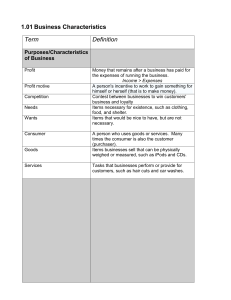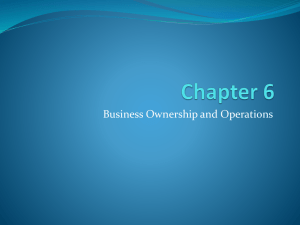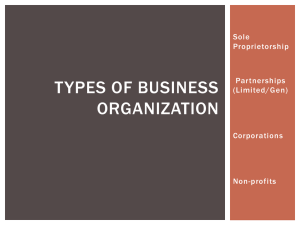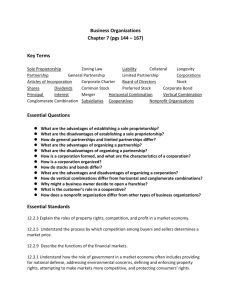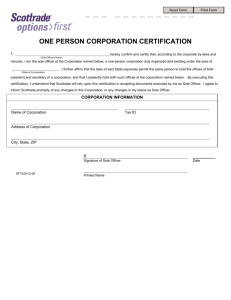Discussion Guide OBJECTIVES A – Explain the most common forms
advertisement
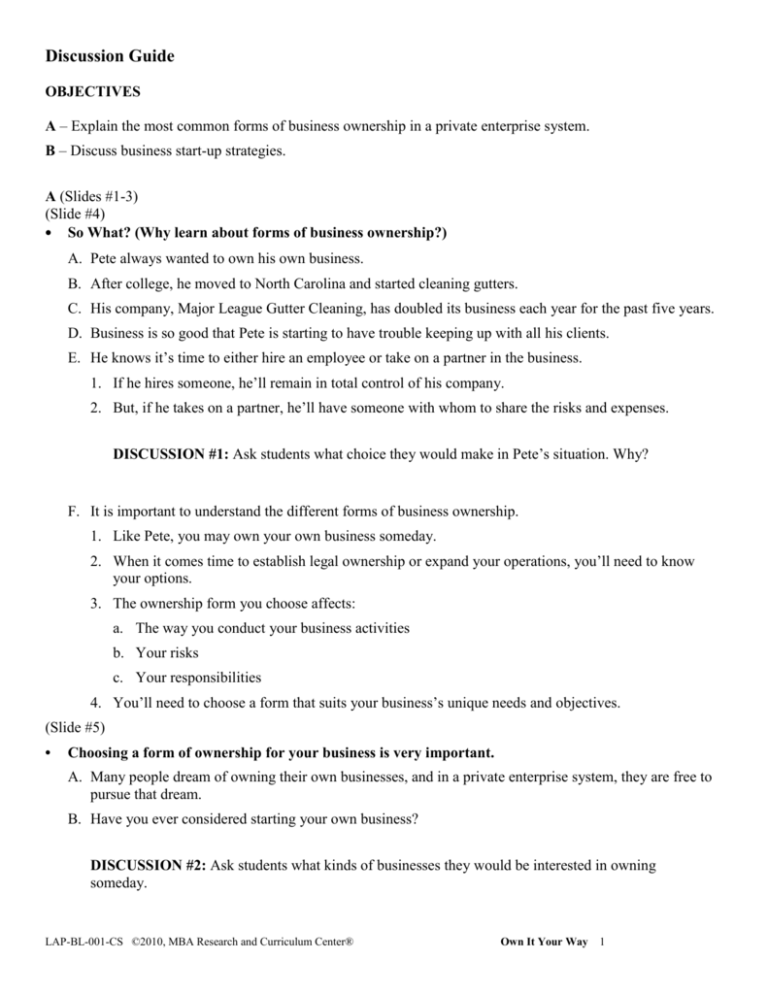
Discussion Guide OBJECTIVES A – Explain the most common forms of business ownership in a private enterprise system. B – Discuss business start-up strategies. A (Slides #1-3) (Slide #4) • So What? (Why learn about forms of business ownership?) A. Pete always wanted to own his own business. B. After college, he moved to North Carolina and started cleaning gutters. C. His company, Major League Gutter Cleaning, has doubled its business each year for the past five years. D. Business is so good that Pete is starting to have trouble keeping up with all his clients. E. He knows it’s time to either hire an employee or take on a partner in the business. 1. If he hires someone, he’ll remain in total control of his company. 2. But, if he takes on a partner, he’ll have someone with whom to share the risks and expenses. DISCUSSION #1: Ask students what choice they would make in Pete’s situation. Why? F. It is important to understand the different forms of business ownership. 1. Like Pete, you may own your own business someday. 2. When it comes time to establish legal ownership or expand your operations, you’ll need to know your options. 3. The ownership form you choose affects: a. The way you conduct your business activities b. Your risks c. Your responsibilities 4. You’ll need to choose a form that suits your business’s unique needs and objectives. (Slide #5) • Choosing a form of ownership for your business is very important. A. Many people dream of owning their own businesses, and in a private enterprise system, they are free to pursue that dream. B. Have you ever considered starting your own business? DISCUSSION #2: Ask students what kinds of businesses they would be interested in owning someday. LAP-BL-001-CS ©2010, MBA Research and Curriculum Center® Own It Your Way 1 C. Whether you want to produce movies, design video games, or even start a new airline, one thing is true—you’ll have to establish a legal form of ownership for your business. (Slide #6) D. The way you structure your company depends on: 1. Your personal circumstances 2. Your financial needs 3. The type of business you are starting (Slide #7) E. Choosing an appropriate structure is very important because it affects issues such as: 1. Taxation 2. Liability 3. Ownership control F. There are millions of businesses operating in the United States today. G. Most of them operate under one of four forms of business ownership: 1. Sole proprietorship 2. Partnership 3. Corporation 4. Hybrid structure H. As businesses grow, their needs sometimes change. I. Owners might decide to alter the ownership form to better meet the company’s objectives. J. But, before you can decide what is best for your business, you must know how each form of ownership works. (Slide #8) • A sole proprietorship is a business owned by one person. A. The owner receives all the profits from the business and takes all the risks. 1. By taking all the risks, a sole proprietor experiences unlimited liability. 2. This means that any debts that the business owner owes can be collected from his/her personal assets or belongings. 3. In other words, if the owner cannot pay business-related debts, bill collectors can take her/his car, boat, or home as payment. (Slide #9) B. Nearly 80 percent of the businesses in the U.S. are sole proprietorships. C. They are usually small, employing fewer than 50 people. D. This form of ownership is often chosen for businesses that can easily be managed by the owner or by someone the owner hires. E. Sole proprietorships are often found in small, local businesses and home-based businesses. F. Example: LAP-BL-001-CS ©2010, MBA Research and Curriculum Center® Own It Your Way 2 1. Consider the accountant who lives down the street from you and prepares taxes for people in his own home. 2. His business is a sole proprietorship. DISCUSSION #3: Ask students to give more examples of sole proprietorships. G. Most sole proprietors do not need to address complicated legal issues within this form of ownership. 1. However, depending on the type of business, the owner might need to obtain local permits or licenses to operate equipment, machinery, vehicles, etc. 2. Some business owners, such as hair stylists, must be certified and licensed in the state in which they work. (Slide #10) 3. For the most part, though, sole proprietorships receive minimal government intervention. 4. Business and individual taxes are not separated, and owners claim business taxes on their personal income tax returns each year. H. In many cases, sole proprietors do not need a lot of capital to get started. 1. Your accountant neighbor, for instance, may need only to pay for some business cards to get his business going. 2. If sole proprietors need start-up funds, however, they can obtain them from private investors or bank loans (if they meet lender qualifications). 3. Sometimes, sole proprietors use personal savings or cut back on personal expenses to get their businesses off the ground. DISCUSSION #4: Ask students to think of more examples of sole proprietorships that can be started without a lot of capital. (Slide #11) • A partnership is a business that is owned by two or more people. A. Often, the purpose of forming a partnership is to combine the capital (money), experience, and abilities of the individual owners. B. In this form of ownership, the business partners share both the chance for profits and the risk of loss. C. The partners decide what each owner will contribute to the business and what each will get out of it. D. Example: 1. You decide to form a partnership with your brother. 2. The two of you want to open an art gallery. 3. He can provide the start-up funds for rent, utilities, and advertising. 4. You can provide the expertise to choose the artwork and run day-to-day operations. 5. By partnering together, you can form a business that neither of you would be able to start alone. LAP-BL-001-CS ©2010, MBA Research and Curriculum Center® Own It Your Way 3 (Slide #12) E. There are two basic types of partnerships. 1. In the most common form, a general partnership, each partner has unlimited liability. 2. Just as in a sole proprietorship, business debts can be paid by taking some or all of each partner’s personal assets. 3. A limited partnership, on the other hand, permits a partner to invest money in a business but have limited liability. a. For example, the amount of financial responsibility could be limited to the amount the partner invested. b. If the partner invested $5,000 in a business, that is all s/he would lose if the company went out of business. c. Setting up a limited partnership is a little more complicated than establishing a general partnership because the government requires partners to comply with a number of different rules and restrictions. F. The laws governing business partnerships vary from state to state. G. Like sole proprietorships, partnerships can be used in most businesses. H. They are often found in businesses that offer more than one product, such as car dealerships that offer both sales and service. DISCUSSION #5: Ask students to give more examples of partnerships (real or hypothetical). (Slide #13) • A corporation is a business that can have many owners. A. What do iPods, Hershey’s kisses, and DC shoes have in common? B. All of these products are produced by corporations. C. The U.S. Supreme Court defines a corporation as an “artificial being, invisible, intangible, and existing only in contemplation of the law.” D. As a business, a corporation functions independently of its owners but is treated as a person with legal rights, duties, and powers. E. Because the corporation is considered separate from its owners, the owners are not liable for the company’s actions, and their personal property cannot be taken to pay outstanding debts. F. Owners are only liable for the amount they invested in the company. (Slide #14) G. A corporation can: 1. Borrow and lend money 2. Buy and sell goods 3. Make contracts 4. Sue or be sued LAP-BL-001-CS ©2010, MBA Research and Curriculum Center® Own It Your Way 4 5. Have an unlimited life span (Slide #15) H. To be an owner of a corporation, a person purchases shares of stock and becomes a stockholder (or shareholder). I. The more shares of stock a person owns, the more control the person has over the business. J. The corporation form of ownership is suitable for almost any type of business. 1. It is often used for businesses that require large amounts of capital (e.g., airlines and manufacturing). 2. Businesses with uncertain futures, such as new magazine publishers or entertainment ventures, are also well-suited for a corporation business structure. K. In the U.S., corporations are in the minority as a form of business ownership; however, they generate a majority of sales. L. Because of the complex nature of corporations, they are subject to more government regulation than sole proprietorships or partnerships. DISCUSSION #6: Ask students to give more examples of corporations. M. Corporations are governed by a board of directors. 1. This board consists of people, sometimes stockholders, who make decisions about the activities of the business. 2. The company’s officers (e.g., president, chief financial officer) execute these decisions and run the day-to-day aspects of the business. • Corporations are generally established as one of four types—private (or close), “S,” public (or open), or nonprofit. A. Each type of corporation must meet specific legal guidelines. B. The type of corporation also determines the way it is taxed by the government. (Slide #16) C. A private (or close) corporation does not offer shares for sale to the general public, meaning that it might have just a few shareholders. 1. In many cases, the shareholders also operate and manage the business. (Slide #17) 2. A private corporation is usually not required to make its financial activities public, but for tax reasons, it must prepare reports for the state in which it operates. 3. A private corporation is taxed by the government in two ways. 4. First, it is taxed on the profits made by the company itself. 5. Second, the shareholders are taxed on the dividends they earn on their investments. 6. This is often called dual (or double) taxation. LAP-BL-001-CS ©2010, MBA Research and Curriculum Center® Own It Your Way 5 DISCUSSION #7: Ask students what they think the advantages are to structuring your company as a private corporation. (Slide #18) D. A Subchapter “S,” or “S” corporation, is a private corporation with special benefits designed to help small businesses. 1. By taxing the corporation as if it were a partnership, the “S” corporation avoids dual taxation. 2. This saves the owners a lot of money in taxes. 3. To qualify as an “S” corporation, the company must have 100 or fewer shareholders and adhere to a number of other government policies. (Slide #19) E. A public (or open) corporation can sell millions of shares of stock to the general public. 1. Because anyone can purchase stock, there can be thousands of stockholders in just one company. 2. Public corporations are subject to more government regulation and taxation than other forms of business ownership. 3. In addition, federal law mandates that public corporations provide financial information (e.g., earnings, assets, debts) to the public and prospective investors. 4. This information is outlined in a formal document called an annual report. 5. And, like private corporations, public corporations are subject to dual taxation. (Slide #20) F. A nonprofit (or not-for-profit) corporation is an organization that operates to accomplish a specific mission—other than to make a profit. 1. Generally, the purpose of the organization is to help society, and income is used to fund programs and cover operational expenses. 2. Institutions that are charitable, educational, religious, or scientific in nature are usually established as nonprofit corporations. 3. Example: a. The American Red Cross defines its purpose as being “…a humanitarian organization led by volunteers…to provide relief to victims of disasters and to help people prevent, prepare for, and respond to emergencies.” b. To accomplish its mission, the American Red Cross provides community services to help the needy, organizes blood drives, and administers domestic and international relief programs. 4. Because nonprofit organizations like the Red Cross are established to benefit society, this form of business ownership is generally not taxed by the federal government. 5. Many nonprofits rely on donations and grants as sources of funding. DISCUSSION #8: Ask students to give more examples of nonprofit corporations. LAP-BL-001-CS ©2010, MBA Research and Curriculum Center® Own It Your Way 6 (Slide #21) • There are three ways that corporations can grow once they’ve been established. A. The first is through a merger with another company. 1. A merger occurs when two individual businesses combine to form one company. 2. This usually happens when a larger company purchases, or acquires, a smaller company (referred to as an acquisition). B. Another way a corporation can grow is through consolidation. 1. This is the act of acquiring many smaller companies. 2. An example of consolidation can be seen when one large bank buys several small local banks. (Slide #22) C. Lastly, corporations can grow through expansion. 1. A company may want to expand its operations (adding a new product line, for instance) or build a new facility. 2. To do so, the company will need more capital. 3. It can obtain this capital in a few different ways—by selling more shares of stock, by reinvesting its profits back into itself, or perhaps by obtaining a bank loan. DISCUSSION #9: Ask students if they can think of any examples of acquisitions or consolidations that have occurred in their towns. (Slide #23) • A newer type of business ownership referred to as a hybrid structure allows owners, who are called members, to enjoy the advantages of corporations and either sole proprietorships or partnerships. A. Depending on the number of owners, a hybrid business can be structured in one of two forms—as a limited liability partnership (LLP) or a limited liability company (LLC). B. Members determine how the company will be managed and how the profits will be shared. (Slide #24) C. Characteristics of hybrid business structures include: 1. Limited liability—Personal assets cannot be taken to pay the company’s debts. 2. Limited life—Most states require that the company dissolve after a certain amount of time and/or upon the death, retirement, or resignation of an owner. 3. Limited taxation—Taxes are claimed only on individual members’ personal income tax returns. 4. Unlimited owners/partners—Hybrid structures can have as many members as desired. D. Many professional service businesses (e.g., doctors, attorneys, accountants) structure ownership as LLPs. 1. This form of ownership is used primarily to protect innocent partners from the malpractice of other partners. 2. For example, the LLP structure protects partners in a doctor’s office if another doctor in the practice is sued by a patient. LAP-BL-001-CS ©2010, MBA Research and Curriculum Center® Own It Your Way 7 E. Many states require that LLCs have at least two owners, although some states require only one. 1. Like general partnerships, LLCs should develop detailed agreements, known as operating agreements, specifying each member’s role in the company. 2. LLCs are suitable for most types of businesses. DISCUSSION #10: Ask students if they can think of any specific LLPs or LLCs in their towns. (Slide #25) B (Slide #26) • Another option to consider when starting a business is acting as an agent to an existing company. A. In other words, you’ll find many ownership opportunities with existing companies through franchising, multi-level marketing, licensing, and developing joint ventures. B. By exploring these methods of ownership, you can decide which strategy is right for you. • Franchising is a method of distributing recognized goods and services through a legal agreement between two parties. A. The franchisor is the seller or parent company who owns the company name or trademark rights. (Slide #27) B. The franchisee acquires the rights to operate the business using the parent company’s name. C. For someone who wants to be a business owner, purchasing a franchise is often a desirable ownership option because the product has an established brand with a solid reputation. DISCUSSION #11: Ask students to give examples of franchise businesses in their towns. D. To own a franchise, you must first sign a franchise agreement with the franchisor and pay an initial franchise fee. 1. Fee amounts vary but are usually in the $20,000 - $30,000 range. (Slide #28) 2. As a franchisee, you are also responsible for costs related to facility construction or leasing, equipment, insurance, and legal fees. 3. You might also pay a royalty fee to the parent company based on a percentage of your profits. 4. In addition, you might pay fees to cover advertising expenses. 5. As you can see, starting a franchise can be very expensive but can also be very profitable in the long run. E. Sometimes, the franchisor establishes a relationship with another person or firm (known as a master licensee) who helps find franchisees in a particular region or territory. LAP-BL-001-CS ©2010, MBA Research and Curriculum Center® Own It Your Way 8 1. Depending on the terms established with the parent company, the master licensee might provide support for franchises in the form of training or warehousing. 2. Land developers and other groups or individuals often purchase franchise rights from a business and open several outlets in a specific area. 3. This type of multiple-unit business ownership is a growing trend in the business world. F. Franchises can be established in two basic formats: (Slide #29) 1. Business-format franchise a. This franchise arrangement is usually available to anyone who has the capital to invest. b. It requires a close and continuous working relationship between the franchisor and the franchisee. (Slide #30) c. Franchisors often provide training, financial guidance, and supply channels for franchisees. d. In turn, franchisees benefit from the franchisor’s national advertising programs, since they operate under the same trade name. e. This reduces the franchisee’s risk of business failure. f. On the flip side, franchisees are often limited to offering specific goods and services, using certain vendors, operating at certain hours, and presenting certain appearances. g. Business-format franchises can be found in almost any industry. (Slide #31) h. Within the business-format franchise, piggyback franchising has become popular. 1) This is a form of ownership in which a retail franchise operates within the facilities of another store, often referred to as the host. 2) For example, a Wal-Mart might host a McDonald’s or Subway franchise. 3) This arrangement benefits both the franchisee and the host. The host increases its product line, while the franchisee has access to the host store’s customers. DISCUSSION #12: Ask students to give more examples of piggyback franchises. (Slide #32) 2. Product trade-name franchise a. This is an independent sales relationship between a supplier (franchisor) and a dealer (franchisee) to stock and sell a specific or exclusive line of products. (Slide #33) b. Some of the major characteristics of a product trade-name franchise include: 1) Products are usually bought on consignment or straight from the supplier/manufacturer. 2) The name of the business is chosen by the franchisee. LAP-BL-001-CS ©2010, MBA Research and Curriculum Center® Own It Your Way 9 3) The franchisee usually must have a great deal of experience and financial ability before the franchisor will agree to the arrangement. c. Product trade-name franchisees are commonly referred to as dealerships or exclusive distributorships. d. They are often used in the automobile, large appliance, soft-drink, and petroleum-product industries. e. Example: 1) Your local Ford dealership 2) The business name may be something like Sam Roberts Ford—Sam Roberts is the franchisee, and Ford is the franchisor. (Slide #34) • Multi-level marketing businesses pay commissions on sales to people at two or more levels. A. The sales representatives usually work independently of the company, not only selling products, but trying to get others to sell them as well. B. The representatives receive payouts from the sales of other people “under” them. (Slide #35) C. Characteristics of legitimate multi-level marketing businesses include the following: 1. People become representatives (distributors) because they have used the product and liked it. 2. Most distributors are home-based and offer flexible scheduling. 3. Most representatives can get started for $100 or less—this money is generally used to cover the cost of instructions, samples, and promotional materials. 4. Commission and bonus structures differ between companies—some companies offer incentives or prizes, such as cars, for attaining a set sales goal. 5. The representatives determine how much income they generate by the amount of time and energy they put into developing their business contacts. D. There are many opportunities in multi-level marketing. E. Some successful multi-level marketing ventures are: 1. Longaberger baskets 2. Arbonne cosmetics 3. Pampered Chef kitchen products 4. Lia Sophia jewelry DISCUSSION #13: Ask students to give more examples of multi-level marketing businesses. What do they think of this type of business? Would they be interested in getting involved with one? F. Before you get involved in multi-level marketing distribution, make sure that you examine the company very carefully. LAP-BL-001-CS ©2010, MBA Research and Curriculum Center® Own It Your Way 10 1. Unfortunately, there are many pyramid schemes that operate illegally. 2. Typically, these schemes require potential members to pay a large investment fee up front. 3. Most of their emphasis is on recruiting new members so that more investment fees can be collected. 4. Very little emphasis is placed on product attributes or quality. 5. Always check out a company with the Better Business Bureau or Direct Selling Association before becoming involved with it. (Slide #36) • Licensing refers to an owner’s authorization or permission for another entity to use trademarked, copyrighted, or patented material for a specific activity, during a specific time period, for the profit of both parties. (Slide #37) A. The licensor is the owner of the material, and the licensee is the buyer. B. In many licensing agreements, the licensee pays royalties, or a percentage of the profits, to the licensor in addition to an initial licensing fee. C. Because terms vary and each situation is unique, you should consult a lawyer to develop licensing agreements. D. These agreements are usually very specific, and improper use of licensed material may result in a lawsuit. (Slide #38) E. Many types and sizes of businesses grant licenses for many things, including: 1. Technological information 2. Intellectual information (e.g., research findings) 3. Industrial processes or methods 4. Formulas or recipes 5. Recognized brands, names, or logos 6. Music and art 7. Inventions F. As a business owner, you may be the licensee or the licensor. 1. Perhaps you have a great product idea and want to use your favorite professional sports team logo on the item. 2. In this instance, you are the licensee because you must receive permission to use the logo. 3. If you have developed an invention or process that someone else can manufacture or distribute, you are the licensor. DISCUSSION #14: Ask students to give examples of licensed products they have seen in the past week. LAP-BL-001-CS ©2010, MBA Research and Curriculum Center® Own It Your Way 11 (Slide #39) • Joint ventures, or strategic alliances, occur when two or more businesses enter into a relationship by combining complementary resources such as technology, skills, capital, or distribution channels for the benefit of all parties. (Slide #40) A. The relationship is usually short term and involves a single project or transaction. B. A limousine service, for example, might partner with a local television station for a year, providing free transportation for the station’s guests in exchange for free on-air advertising. C. Joint ventures are becoming a popular way to expand businesses. D. Alliances can help businesses reach new target markets and develop new profit centers for less money than it takes to do it alone. E. This type of business strategy can work at all levels—from the large corporation to the sole proprietorship. F. This is a popular business strategy in real-estate development and in businesses that want to expand internationally. (Slide #41) • Make It Pay A. Think of the businesses in your town. B. Name one example of each of the following: 1. Sole proprietorship 2. Partnership 3. Corporation 4. Nonprofit corporation 5. Franchise C. Which of these types of businesses would you like to own? D. Why? LAP-BL-001-CS ©2010, MBA Research and Curriculum Center® Own It Your Way 12 (Slide #42) • The Gray Zone A. When a business decides to incorporate as a public (or open) corporation, it offers shares to the public in an IPO, or initial public offering. B. There are a number of laws and regulations regarding IPOs; however, companies often find ways to make IPOs work to their advantage, even if it seems unfair. C. For example, a company might offer shares for sale at $10,000 per share or restrict potential investors from buying in unless they purchase a certain number of shares. (Slide #43) D. In essence, these IPOs “shut out” smaller investors and make shares available only to wealthier individuals or institutional investors that are investing for their clients. E. Although this is not illegal, many people consider it to be unethical. F. What do you think? LAP-BL-001-CS ©2010, MBA Research and Curriculum Center® Own It Your Way 13


